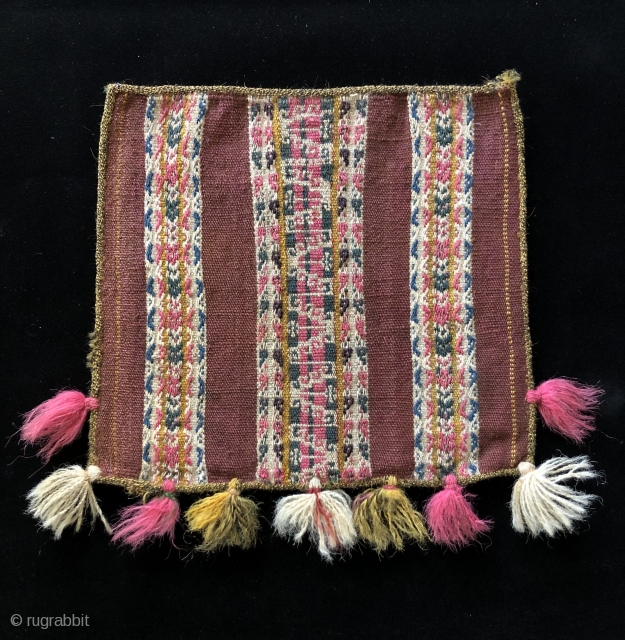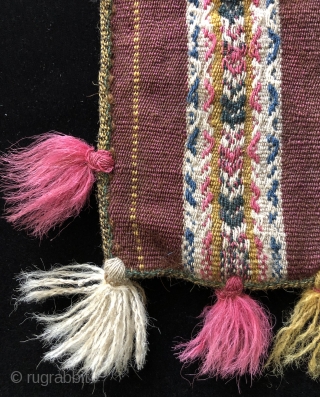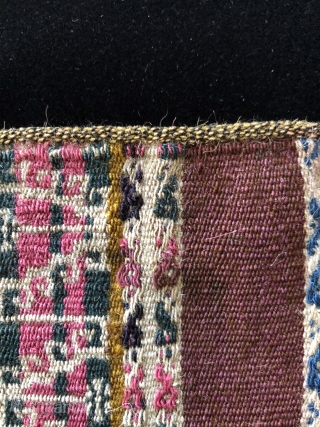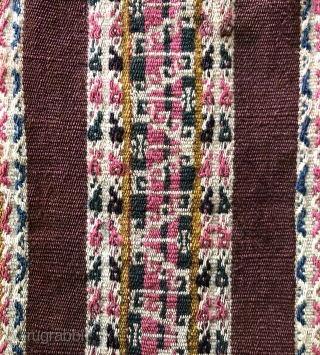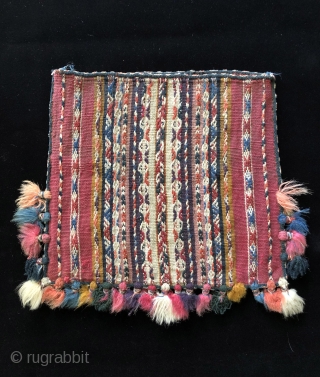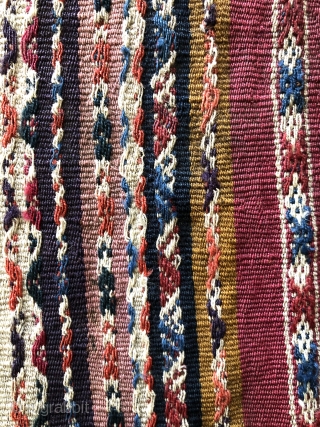Back
Tutorial part 5 – Two more coca bags from the Bolivar region.
Bolivar is one of the largest weaving regions in Bolivia. The general style of Bolivar textile design is easily recognizable even though there is a lot of variation in pattern and color to be found there. a surprising number of Bolivar textiles have survived from the 19th century and before - until the present. Part of this is due to the number of weavings made in the region, but more importantly it has to do with the strong tradition of preserving old textiles for future generations among the Aymara. This tradition developed partly in response to the Spanish conquest of indigenous Native Americans of the Andean region.
The Aymara and Andean people in general practiced a form of ancestor worship that persevered for millennia. When the Spanish arrived in the Andes in the 1500’s they proceeded to wipe out large numbers of indigenous people through warfare, the introduction of foreign diseases and forced labor practices. The Spanish priests who followed the conquistadors were especially diligent in trying to forcefully convert the Indian populations to Catholicism. They made every effort to ban practices of the native peoples that they deemed to be against the “one true faith”. One of these native practices was the internment of the dead – one’s ancestors - in graves that were accessible to the living such as cave burials and stone or adobe burial towers. For the Aymara there was no separation between the living and the dead – all were part of the same family. The ancestors were revered and treated with great care and respect even after death. Before the Spanish arrived in the region Aymara ancestors were carefully interred and curated by the living in above ground burial chambers. They were consulted on important decisions and treated with great respect. Ancestors were placed in chambers, dressed in fine textiles with other precious objects. They were visited on numerous occasions and anointed with coca leaves, alcohol and other offerings during various ceremonies and rituals. For the Spanish priests these ancestor worship-like practices were considered idolatrous and banned. Spanish missionaries ruthlessly searched out and destroyed every burial place they could find, burning the dead in an attempt to convert the Aymara and to destroy their traditional culture. As a result, the Aymara began to keep the textiles and other belongings of their ancestors in curated textile bundles. Since the bodies of the dead were no longer allowed to be kept, the textiles of the ancestors were kept instead - literally becoming the embodiment of the ancestors themselves. Textiles were preserved by some families in this way and sometimes kept communally in sacred bundles called q’epes. This is one of the reasons certain Aymara textiles of great age have survived for so long in such humble abodes. Even today, in a few remote areas of Bolivia, bundles of ancient textiles are opened up a few times a year and the cloth of the ancestors are put on by their descendants and danced in ceremonies and festivals literally re-animating the ancient ones.
The two Bolivar bags seen here provide another perspective on the weavings of this area. One quite different from the previous post. Both bags are excellent nineteenth century examples in remarkable condition. Each displays a different aesthetic preference, but both are made by Aymara weavers in different parts of the greater Bolivar region and are classic examples. The first bag shows an aesthetic that is closer to some pre-Columbian coca bags that originate from the far South of the modern day Peru and the far North of Chile. The inhabitants of these areas were Aymara speakers with a distinct connection to the Altiplano region Aymara. This bag has three pattern bands of complimentary warp weave spaced out on a plain warp-faced ground weave. The ground weave area is made up of yarns that are bi-chrome alpaca yarns which are two-ply and consist of a combination of a pale rose to lavender yarn dyed with cochineal and a natural un-dyed brown alpaca yarn twisted together. The resulting color is a unique rose/brown combination. This bag has clear, bright colors including a yellow/gold color that like all yellows found in Aymara weavings does not fade. Whatever the yellow dye that was used here is – it is typical of Aymara yellows in that it is amazingly light fast unlike most yellows found it other areas of the world like the Near East and Central Asia. The Aymara had some excellent, world class dyes. The edge finish of this bag is a ribete’ that uses bi-chrome yarns in black and yellow or yellow and green.
The second bag has a rainbow of color arrayed across its surface. Its ribete’ (edge finish) is the type with little “eyes” as the Aymara would say - on a blue/green ground. The bag has about ten colors including a good deep cochineal purple. Cochineal is a versatile dyestuff that can produce everything from pale pinks to deep reds and everywhere in between. It is also the dyestuff that produces the fantastic number of shades of purple seen in Aymara weavings. An unusual feature of this bag is the white section through the center of the bag. White is not often used this way in Bolivar bags. It is mostly used in patterning bands for contrast and not as a “ground” color as is seen here.
price:
SOLD
- Home
- Antique Rugs by Region
- Category
- Profiles
- Post Items Free
- Albums
- Benaki Museum of Islamic Art
- Budapest: Ottoman Carpets
- Gulbenkian Museum
- Islamic Carpets. Brooklyn
- Islamic Textiles. Brooklyn
- Konya Museum: Rugs
- MKG, Hamburg
- MMA: Caucasian Carpets
- MMA: Mamluk Carpets
- MMA: Mughal Indian Carpets
- MMA: Ottoman Carpets
- MMA: Safavid Persian Carpets
- MMA: Turkmen Rugs
- McCoy Jones Kilims
- Ottoman textiles. Met
- Philadelphia Museum
- Rugs and Carpets: Berlin
- Seljuqs at the Met
- TIEM, Istanbul: Carpets
- V&A: Classical Carpets
- Vakiflar Carpets: Istanbul
- Baluch Rugs: Indianapolis
- Gallery Exhibitions
- Jaf an Exhibition
- Alberto Levi Gallery
- Andean Textile
- Christie's London: 2016
- Francesca Galloway
- HALI at 40
- ICOC Washington, DC 2018
- Jajims of the Shahsavan
- London Islamic Week April, 2018
- Mongolian Felts
- Navajo Rugs: JB Moore
- Persian Piled Weavings
- SF Tribal & Textile Art Show 2020
- SF Tribal 2019
- Sotheby's: C. Alexander
- Turkish Prayer Rugs
- Turkmen Main Carpets ICOC 2007










